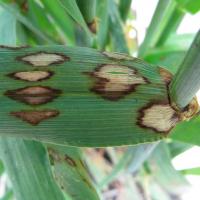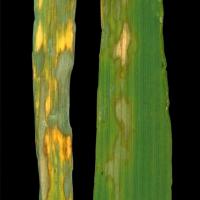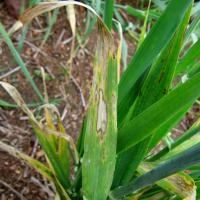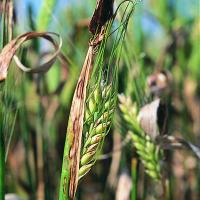Diagnosing barley scald
A stubble and seed-borne fungal foliar disease occurring more frequently in high rainfall cooler areas that can cause grain yield losses up to 45% and reduce grain quality.
What to look for
- Blotched, yellowing and dead leaves generally evenly distributed across the paddock.
- Disease may start as 'hotspots' and rapidly spread, favouring thick crop areas where humidity is high.
- Scald symptoms can be differentiated from other leaf diseases or contact herbicide damage by water-soaked blotches that change into large diamond shaped lesions with a dark brown edge.
Paddock
- First signs are pale grey-green water-soaked blotches on older leaves.
- Blotches become elongated, often diamond shaped, and bleached with a distinctive brown margin. Lesions usually join to form necrotic areas and the entire leaf withers and dies.
- Often the infection spreads up to all parts except the upper stem.
- Symptoms can vary with varietal resistance.
- Shrivelled grain occurs with severe infection.
Plant
Where does it occur?

Wet conditions
- The optimum temperature for both spore production and infection is 15 to 20°C. Rain aids the spread of disease and the most rapid increase in disease is observed in early spring when the temperature and moisture conditions are ideal.
- Early sown crops develop higher levels of scald. Early sown crops may be exposed to the heaviest release of spores from infected residues. The disease can develop in the upper leaves of the plant when conditions favour spread of disease.
- Disease is more severe at higher levels of nitrogen supply.
Where did it come from?

Green bridge
- The fungus is carried from season to season on infected barley and wild grass residues, regrowth barley or infected seed that acts as an initial source of infection.
- Early in the season, wind-blown spores spread over long distances to infect early unprotected sown crops.
- Spores released from initial infection are spread from leaf to leaf by rain splash, so serious disease is seen when there is frequent rainfall and a dense canopy that retains moisture on the leaves for a longer period of time. Drying spring conditions slow the cycle of infection.
- Potassium deficient crops are more susceptible to leaf disease.
Management strategies

Clean seed

Resistant varieties

Stubble management

Spraying fungicide

Top dressing

Grass weed control
- Avoid cropping barley on barley in medium to high rainfall areas.
- Avoid growing highly susceptible varieties.
- Reduce stubble residue carry-over as much as possible.
- Sow clean seed harvested from an uninfected crop, or disease-free certified seed.
- Seed dressing and foliar fungicides can provide effective control.
- Treat for potassium deficiency if economically viable to do so.
- Control barley grass.
See also
Where to go for expert help
Page last updated: Wednesday, 15 April 2015 - 4:07pm





